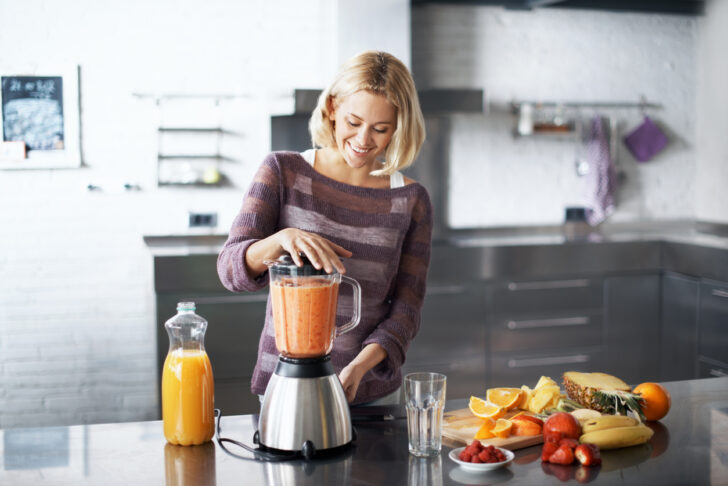
In the pursuit of a healthier lifestyle, selecting the appropriate kitchen appliance can significantly impact one’s outcomes. Both blenders and juicers play essential roles in the preparation of nutritious beverages; however, they serve distinct functions and offer unique advantages. This article examines the key differences between these two appliances, provides reviews of the top 10 blenders and juicers for 2025, and outlines important factors to consider when making a selection. Furthermore, maintenance tips and delicious recipes will be presented to enhance the blending and juicing experience. Prepare to explore the tools that can aid in advancing your health journey.
Table of Contents
Key Takeaways:
- Invest in a high-quality blender or juicer for your kitchen to easily incorporate healthy drinks into your daily routine.
- Consider factors such as type, price, size, and additional features when choosing the best blender or juicer for your needs.
- Properly cleaning and maintaining your blender or juicer is essential for its longevity and ensuring safe consumption of your healthy drinks.
Differences Between Blenders and Juicers
Blenders and juicers are two essential kitchen appliances that fulfill distinct purposes, each offering unique benefits for the preparation of healthy beverages. Blenders are engineered to create smoothies, frozen drinks, and various blended mixtures utilizing high wattage and powerful motor capabilities. In contrast, juicers are designed specifically to extract liquid from fruits and vegetables while discarding the pulp.
A clear understanding of the differences between these versatile kitchen tools enables individuals to make informed decisions based on their culinary requirements, whether they are preparing a strawberry kale smoothie or extracting juice for its nutritional advantages.
Blenders offer a user-friendly experience, accommodating a variety of blending techniques such as puréeing, emulsifying, and crushing ice. This results in thick and creamy textures that retain fiber and nutrients. Conversely, juicers are optimized for the efficient extraction of vitamins and minerals, making them particularly suitable for individuals seeking concentrated nutritional benefits. For context, Health.com provides a comprehensive comparison between juicing and blending, highlighting which is healthier.
Performance evaluations of each appliance typically indicate that while blenders excel in versatility, juicers may prevail in extracting pure liquid, depending on individual dietary preferences. Ultimately, assessing specific needs for smoothies or juices will guide individuals toward the appropriate choice for their kitchen.
Top 10 Blenders and Juicers for Healthy Living
In the pursuit of a healthy lifestyle, possessing the appropriate equipment in the kitchen can have a substantial impact.
This guide outlines the top 10 blenders and juicers that have undergone comprehensive testing by Good Housekeeping to ensure they adhere to the highest standards of performance, ease of use, and versatility. For those seeking further insights into reliable kitchen appliances, Consumer Reports, a respected source in product reviews and ratings, provides an extensive evaluation of various kitchen tools.
Whether one seeks the finest blenders for smoothies or the most efficient juicers for extracting nutritious juices, these appliances are engineered to enhance the culinary experience, facilitating the preparation of delicious and healthful beverages at home.
Product Reviews and Features
Product reviews play a crucial role in evaluating the features and performance of various blenders and juicers, allowing individuals to make informed decisions that align with their culinary requirements.
Each model is subjected to rigorous performance testing, which assesses critical aspects such as motor strength, blending power, and overall user experience. This thorough evaluation ensures that consumers select appliances that excel in their intended functions.
Whether one is in search of a portable blender for smoothies on the go or an immersion blender for soup preparation, these reviews provide insights into durability, aesthetic design, and any included accessories.
Along with performance metrics, user testimonials frequently address the ease of cleaning, which is an important factor in selecting kitchen appliances. Many users report that models featuring removable blades or dishwasher-safe components significantly reduce the time and effort required for maintenance.
Versatility is another essential consideration; certain blenders offer multiple speed settings and attachments that accommodate a range of culinary tasks, from crushing ice to preparing nut butter. According to HGTV’s expert opinion, selecting the right kitchen appliance requires understanding these features to enhance overall functionality.
Analysts have highlighted the nutritional advantages of utilizing these appliances, often noting that blending preserves nutrients more effectively than traditional cooking methods. Authentic customer testimonials further illustrate how these products enhance daily meal preparation, making healthy eating more accessible to a broader audience.
Factors to Consider When Choosing a Blender or Juicer

Selecting the appropriate blender or juicer for your kitchen necessitates a thoughtful evaluation of several critical factors that influence both performance and usability.
Considerations such as price, budget constraints, size, and available capacity options are essential to understand in order to make an informed decision.
Furthermore, assessing additional features—such as variable speed control, pre-programmed settings, and overall ease of use—can significantly enhance the blending or juicing experience, thereby maximizing the value of your kitchen investments.
Type of Juicer or Blender
When selecting among various types of juicers and blenders, it is essential to comprehend the distinct functionalities that each type provides. For instance, immersion blenders are notable for their ease of use and portability, making them particularly suitable for preparing soups and sauces. In contrast, personal blenders are specifically designed for single servings and smoothies.
Additionally, a blender combo may feature versatile attachments, such as a food processor, thereby enhancing functionality within the kitchen.
These distinct appliances can significantly enrich one’s culinary experience, as each is tailored to meet specific needs effectively. For example, centrifugal juicers are proficient at quickly extracting juice from hard fruits and vegetables, whereas masticating juicers operate at a slower pace but offer higher nutrient retention from leafy greens. This versatility enables users to customize their choices according to dietary preferences and health objectives.
With a variety of high-performance options available, consumers can enjoy a broad spectrum of textures and flavors, whether they are puréeing, crushing, or emulsifying ingredients. This adaptability ensures that both casual cooks and culinary enthusiasts have access to the appropriate tools to elevate their cooking and juicing endeavors.
Price and Budget
When determining the price and budget for a blender or juicer, it is essential to assess your culinary requirements in conjunction with your financial constraints. There are affordable options available that do not compromise on essential features, while high-end models often provide advanced capabilities and enhanced durability which may warrant a higher investment.
By gaining an understanding of the price range associated with various models, individuals can make informed decisions that align with their budget while still benefiting from a high-quality kitchen appliance.
Selecting the appropriate appliance necessitates a thorough evaluation of functionality in relation to cost, as certain devices may include superfluous features that increase the price without improving usability. Prioritizing specific functions based on one’s cooking habits, such as the need for ice crushing or achieving a particular smoothie consistency, enables consumers to identify models that offer genuine value.
This careful consideration of affordability against investment not only maximizes the potential of the kitchen but also ensures satisfaction with the purchase. Ultimately, a well-structured budget aids in the identification of a blender or juicer that fulfills both practical and economic requirements.
Size and Capacity
The size and capacity of a blender or juicer are critical factors in assessing its suitability for your kitchen, particularly when space is a consideration. Compact designs are ideally suited for smaller kitchens or for individuals requiring a portable blender for smoothies on the go, whereas larger capacity options are more appropriate for families or meal preparation.
A thorough understanding of one’s blending needs will guide the decision-making process regarding the appropriate size and capacity for optimal kitchen enhancements.
For example, a compact blender can conveniently fit within a kitchen drawer or on a limited countertop, ensuring accessibility without overwhelming the available space. Conversely, individuals who frequently entertain guests or engage in batch cooking may find that a larger model not only saves time but also enhances functionality, enabling the preparation of large quantities of soups, sauces, or juices simultaneously.
Larger models are often equipped with more powerful motors and advanced features, which can further enrich the culinary experience.
By carefully evaluating personal needs, one can make an informed decision that balances spatial constraints with the desired cooking capabilities.
Additional Features
Additional features significantly enhance the blending and juicing experience, making it essential to consider them when selecting the appropriate appliance.
For example, certain blenders are equipped with smart technology that enables users to connect their devices to a smartphone application, allowing for the monitoring of blending times and nutritional content from any location within the kitchen.
This feature not only adds a layer of convenience but also promotes healthier habits by facilitating the tracking of daily intake.
Another important consideration is the presence of specialized attachments, such as food processor blades, which expand the appliance’s functionality by enabling users to chop vegetables or prepare dough, thereby saving both time and effort.
Moreover, safety features like automatic shut-off mechanisms can prevent accidents, enhancing the overall user-friendliness of these appliances.
By carefully evaluating these additional benefits, individuals can ensure that they are investing in a kitchen gadget that truly meets their needs.
Tips for Maintaining and Cleaning Your Blender or Juicer
Proper maintenance and cleaning of blenders and juicers are crucial for ensuring their longevity and functionality, enabling the continued enjoyment of healthy beverages for years to come.
Regular cleaning practices not only maintain the appliance in optimal condition but also enhance the overall blending experience.
Utilizing features such as dishwasher-safe components and adhering to best cleaning protocols will aid in preserving the durability of these kitchen appliances while ensuring their performance remains at its best during every blending operation.

Proper Cleaning Techniques
Implementing appropriate cleaning techniques is essential for maintaining the performance of blenders and juicers, ensuring that these appliances remain user-friendly over time. Many modern devices are designed with dishwasher-safe components, facilitating easy cleanup after preparing smoothies or extracting juice from fruits and vegetables. Regular cleaning not only prevents the accumulation of residue but also contributes to the longevity of the appliance through effective maintenance practices.
To clean these machines effectively, users should begin by disassembling the components to ensure that each part is accessible for thorough washing. For blenders, a solution of warm water mixed with a small amount of dish soap can be highly effective; users can simply blend this mixture and then rinse the container afterward.
Juicers, in contrast, may require brushing and soaking, particularly for the fine mesh screens, to ensure optimal performance.
Natural products such as vinegar and baking soda are excellent alternatives for addressing stubborn stains without the use of harsh chemicals. By incorporating these user-friendly cleaning methods into their routine, individuals can maintain their appliances in optimal condition, thereby enhancing the efficiency and enjoyment of meal preparation.
Storage and Maintenance
The effective storage and maintenance of blenders and juicers are essential for optimizing countertop space and ensuring easy access when preparing smoothies or juices. Proper organization not only prevents damage but also maintains a tidy kitchen environment, whether one chooses a compact design suitable for limited spaces or a larger model that necessitates dedicated storage. Understanding the maintenance requirements of these appliances will contribute significantly to their longevity and performance.
To maximize available kitchen space, it is advisable to utilize a designated cabinet or shelf for housing the blender or juicer. This approach keeps the appliances out of sight while ensuring they remain easily accessible when you are prepared to create a nutritious beverage.
Employing clear bins or drawer organizers can facilitate the separation of accessories such as blades, cups, and cleaning brushes, making it straightforward to locate each item and aiding in effective maintenance.
For individuals with limited kitchen space, considering vertical storage solutions or wall-mounted hooks for hanging appliances can help free up countertop space while keeping essential tools readily available.
Regularly inspecting for wear and cleaning components will further enhance functionality, ensuring that your appliances continue to serve you effectively for years to come.
Recipes for Healthy Blended and Juiced Drinks
Preparing delicious and nutritious blended and juiced beverages at home is a fulfilling and enriching experience when utilizing a blender or juicer.
From smoothies featuring frozen fruits to refreshing frozen margaritas, there is a wide array of recipes available that leverage blending techniques to achieve optimal flavor and nutrition.
Whether one is crafting a strawberry kale smoothie for breakfast or a hearty broccoli leek soup for dinner, these recipes serve to inspire culinary creativity while ensuring the nutritional advantages of fresh ingredients are fully realized.
Delicious and Nutritious Options
Exploring nutritious options for smoothies and juices can significantly enhance daily intake of essential vitamins and minerals. Smoothies can be created using a variety of ingredients, such as spinach, frozen fruits, and protein sources, which collectively improve their nutritional profile. In contrast, juices made from fresh fruits and vegetables offer a refreshing boost of flavor along with health benefits that contribute to a healthy lifestyle.
By incorporating ingredients such as kale, chia seeds, and yogurt, individuals can produce smoothies that not only provide excellent taste but also serve as a rich source of antioxidants, fiber, and probiotics. A combination of cucumber, carrot, and apple in juice form not only satisfies thirst but also presents an effective means of supporting hydration while maximizing nutrient absorption.
With numerous combinations available to explore, there is no shortage of appealing creations that cater to diverse palates. This variety makes it easy to enjoy the significant health benefits of fruits and vegetables while also addressing cravings.









